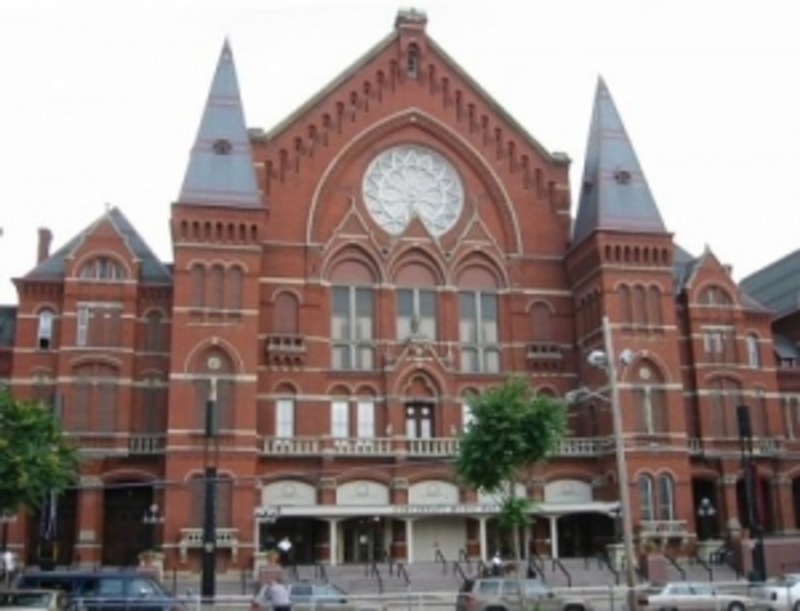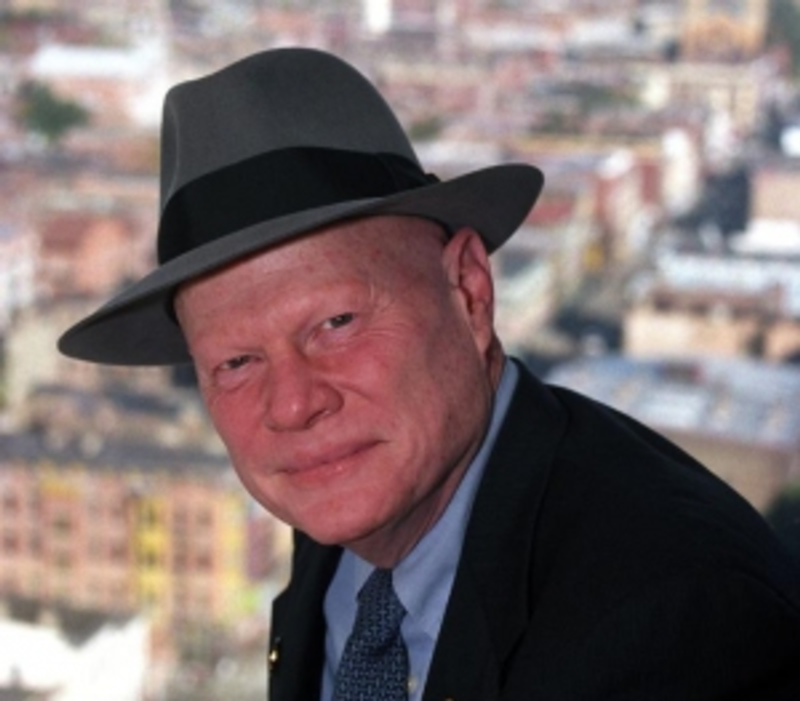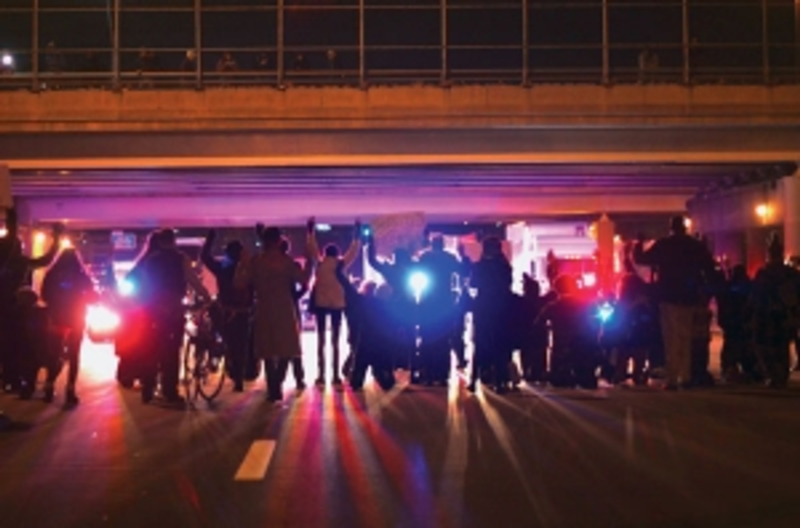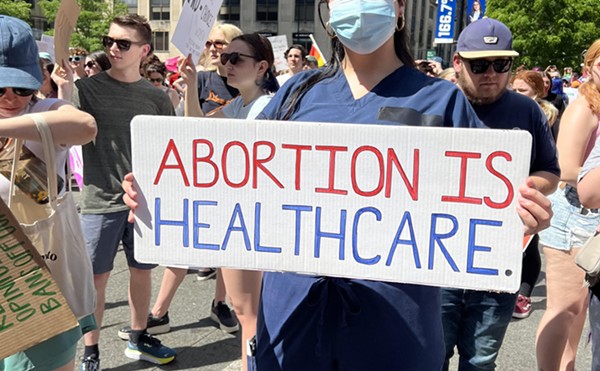The 2015 staff picks for the city's and state's best news and political events and the people involved.
BEST WAY TO MAKE PEOPLE REALLY, REALLY DISLIKE YOU RIGHT BEFORE AN ELECTION
Hamilton County Commissioner Chris Monzel didn’t need votes from Cincinnatians last fall, and he acted like it by deciding, along with fellow Republican Greg Hartmann, that voters wouldn’t get to choose whether or not to fund renovations to Music Hall along with Union Terminal. While Hartmann has a couple years before he has to face voters again, Monzell’s move cutting Music Hall from a sales tax increase to update both buildings was downright ballsy. You don’t mess with our big radio building or our scary German music castle. The icon tax debate that ensued energized Democratic opposition to Monzel, though the last minute scramble for candidates by Dems ensured that the anti-tax commish was still sitting pretty come Election Day.
BEST VICTORY FOR WOMEN’S HEALTH
For a moment, it looked as though Cincinnati would become the largest metro in the country without direct access to abortion services. The state had already stopped abortions at Women’s Med clinic in Sharonville when it started bearing down hard on Planned Parenthood’s Elizabeth Campbell Surgical Center in Mount Auburn, the area’s last remaining clinic providing abortions. The Ohio Department of Health went more than a year without responding to the clinic’s license renewal request, which hinged on a variance to state rules requiring admitting privileges at local hospitals. Then it cited the clinic for not having a license. Planned Parenthood promptly sued, bringing a case that challenged the constitutionality of Ohio’s super-restrictive abortion laws. Ohio relented, granting the clinic a variance and its license. The small-town conservatives running the state legislature will no doubt take another shot at the clinic in due time. plannedparenthood.org.
BEST WASTE OF OHIO TAX DOLLARS FIGHTING ON THE WRONG SIDE OF HISTORY
Ohio Attorney General Mike DeWine and his office spent part of last year struggling against federal court decisions in other states, the leanings of the U.S. Supreme Court and the ongoing tide of history by fighting to preserve Ohio’s constitutional amendment banning gay marriage. The 6th Circuit Court of Appeals upheld bans in Ohio and three other states, but other district courts across the country have struck down similar bans. Kentucky’s AG wouldn’t even touch a similar case, forcing the state to seek private representation. The U.S. Supreme Court struck down a federal ban in 2013 and will hear arguments this spring about Ohio’s ban. This will more than likely end badly for the state (though well for supporters of marriage equality), and taxpayers will be on the hook for the legal bills.
BEST POSSIBLE PASSIVE-AGGRESSIVE ATTEMPT TO SOUR PEOPLE ON THE STREETCAR
Mayor John Cranley’s $300 residential parking pass for Over-the-Rhine, which would have been the most expensive of any major U.S. city, was floated as a way to pay for the streetcar’s operating costs. Cranley and other streetcar foes continually freaked out about how the transit project would be funded, though it turns out there was a perfectly good way to do so without instituting a policy that absolutely no one would like or agree to. In the end, it did take a parking rate hike to pay for the streetcar’s operation costs, but it comes a few cents at a time with a slight increase in metered parking charges in Over-the-Rhine and an increase in parking meter hours in OTR and downtown. That wasn’t so bad, was it?
BEST BIBLE REFERENCES AND GENERAL BEFUDDLING WITTICISMS AT COUNCIL MEETINGS
Cincinnati City Council’s weekly meetings might be a total bore if it weren’t for the sometimes rambling, sometimes confusing, but always entertaining monologues of Councilman Charlie Winburn. Sometimes Winburn’s quips are biblically inspired, like when he asked whether the city might have to split the manager of Greater Cincinnati Water Works in half over a debate on whether he should have to live in the city or not (“Are we going to split Mr. Parrott in two now? Do we have to get Solomon in on this thing?”) Other times, they seem to be pulled out of thin air. In response to other council members asking for details about an upcoming proposal, Winburn once answered, “If I told you that, I’d have to hug you.” Perhaps it’s a legislative strategy: Leave ’em confused, and you’re one step ahead of your political opponents.
Few people know Cincinnati as well as former city councilman, entrepreneur and historic preservation advocate Jim Tarbell. Tarbell was a late addition to last year’s Hamilton County Commissioners race, where he ran as an independent write-in candidate against current Republican commissioner Chris Monzel and Democratic challenger Sean Patrick Feeney. The 27-year-old Feeney had little experience in government and Monzel had just recently aided in a scheme to cut Music Hall out of a sales tax increase designed to fund renovations to it and Union Terminal. Tarbell, who also lost to Monzel in 2010 when he ran as a Democrat, was a long shot at best. But had he won, he would have represented a refreshing change of pace for the county’s Republican-led commission.
BEST TOPIC WE CAN’T BELIEVE WE’RE STILL TALKING ABOUT
Despite all the nay-saying and political wrangling, the Cincinnati streetcar is a reality, gaining more track in the ground every day. But that hasn’t stopped the drama. First, there were questions about where the city would get operating funds for the 3.6-mile transit loop through downtown and Over-the-Rhine, with Mayor John Cranley sounding skeptical notes about the city’s ability to sustain the project financially and threatening to cut operating hours if money couldn’t be found. But a few months later, City Council found a workable solution, combining parking rate increases and some property tax abatement reductions downtown and in OTR. After that problem was solved, there was the collective freak-out about the project’s contingency fund, which officials thought might be dwindling to nothing. But as it turns out, a few cost cutting measures put the fund right back on track, and the streetcar looks ready to roll (or glide or whatever) in September 2016. cincinnati-oh.gov/streetcar.
BEST TECH/SOCIAL JUSTICE HYBRID STORY
Lower Price Hill is one of Cincinnati’s more neglected communities. The gift of free Wi-Fi for the entire neighborhood, provided this fall by tech company Powernet and brokered by Councilman P.G. Sittenfeld, looks to be a major help fighting the enclave’s isolation and poverty. The small neighborhood is nestled on a hillside west of downtown just above the industrial, nearly uninhabited Queensgate area. The community was already struggling when the recession and the housing crisis both hit it hard. Today it has about 1,200 residents, according to Census data, many of whom live below the poverty line. Among those residents are students at Oyler K-12 school, which has been transformed as a community learning center that offers after-school activities and social services. The generous donation allowing Internet access to students and other residents will continue the momentum Oyler’s renaissance started. powernetco.com; oyler.cps-k12.org.
BEST MEMBER OF GOV. JOHN KASICH’S RE-ELECTION CAMPAIGN STAFF
It all started so well — Ed FitzGerald was an experienced, but still youngish, Democratic candidate running against Republican Gov. John Kasich with policy proposals on the progressive side of things. But if you want to run for governor, it’s probably best to air out the skeletons in your closet. Or, you know, not have them in the first place. But someone forgot to let FitzGerald know, at least during the 10 years he was driving without a license, some of them while he was Cuyahoga County Executive. Instead, FitzGerald waited for the press to find this fatal flaw and others like it, sinking his chances of toppling Kasich and (perhaps) sinking the rest of the Democrats’ statewide ticket as well. FitzGerald’s campaign was a textbook disaster, and he has no one but himself to blame.
BEST SKETCHY PRIVATE USE OF PUBLIC TAX DOLLARS
A darling of conservatives in Ohio and beyond, the state’s charter schools showed some serious flaws this year. The charter school movement basically allows private nonprofit and for-profit companies to take public tax dollars to operate schools with less oversight and compliance obligations than a standard public school. Sound like a good idea? Maybe not so much. There was Cincinnati’s VLT Academy, which the Ohio Department of Education shut down last summer after poor performance and questions about financial improprieties. Then there are Concept Schools, which are currently under investigation by the state and the FBI. One of the Chicago-based company’s schools in Dayton, called Horizon Academy, has seen recent accusations from former teachers about forged attendance data, racism and sexual misbehavior among students. This comes as data shows charter schools as a whole generally don’t perform much better, and in many cases are much worse, than traditional public schools.
BEST FORWARD MOVEMENT FOR CYCLISTS DESPITE A BRIEF HALT
There’s something about Cincinnati that forces good ideas to go through multiple needless levels of drama before moving forward. Case in point: the Central Parkway bike lane. Bike commuters making their way from uptown to downtown, casual Red Bike users and even folks out for an occasional jaunt from Clifton to OTR have a new, safe option thanks to the lane, part of Cincinnati’s 2010 Bicycle Transportation Plan. But alas, this piece of progressive cycling infrastructure was almost not to be, and despite its completion the resulting debate has threatened future bike lanes on city streets. Mayor John Cranley paused the project last spring after a single business owner complained about a few parking spots, forcing the city to spend $100,000 to reroute the lane. Cranley used the debate to reroute the city’s priorities on bikes, indicating that he’s more interested in spending money on recreational bike trails like the embattled Wasson Way and Oasis Line trails than on on-street bike lanes folks can use to get to work. That’s so Cincy! cincinnati-oh.gov/bikes.
MOST CREATIVE CORPORATE LAYOFFS
Gannett, the parent company of the Cincinnati Enquirer, hatched its most recent round of staff chicanery last fall, notifying many staff members they would have to reapply for their jobs under new, flashy-sounding titles like “content coach” as well as some more questionable ones like “the black and immigrant experience reporter.” Included in the job descriptions was language about reporters working closely with advertising partners and monetizing audiences. One job description even used the painfully dated term “urban pioneers,” as if some intrepid Gannett corporate guy just now realized that young people love living in cities. You might be able to guess what happened next: a mass exodus of some of the paper’s best and brightest. Even more painful: One job description Gannett didn’t include in its self-described newsroom of the future was the old, trusty copy editor, or “he or she who keeps reporters from looking dumb on a daily basis.” That led the Enquirer’s reporters to, well, look dumb on a daily basis. A newsroom-wide berating by Enquirer editor Carolyn Washburn on the paper’s increasing print flubs followed, which was leaked and posted on prominent media blogs. Washburn may have made a grammatical error in her first few paragraphs, but don’t worry — the missive assured everyone that she spell checked the whole thing.
BEST UNDER-THE-RADAR ISSUE IN CINCINNATI IN 2014
While the tragic death of Kings Mills transgender teen Leelah Alcorn grabbed national headlines this year and brought much-needed attention to trans issues, a part of the story has still been sadly neglected. Violence against transgender individuals, especially those who find themselves incredibly vulnerable because of their transgender status, continues to be a huge problem. Here in Cincinnati, the dangers facing transgender individuals was mostly recently illustrated by the death of Tiffany Edwards, a trans woman who was murdered over the summer in Walnut Hills due to her trans status. Edwards’ death was the second murder of a transperson in as many years in the neighborhood and one of many statewide in that same period of time.
BEST DRAMATIC COURT CASE
Former Hamilton County Juvenile Court Judge Tracie Hunter’s journey has been an intense and bewildering ride. After running on promises that she would radically reform the county’s juvenile justice system, she had to fight to overturn an election decision that initially awarded her judgeship to her opponent. A court battle awarded her the seat. Then the real trouble started. The Cincinnati Enquirer sued her for kicking a reporter out of her courtroom, and other complaints about Hunter’s behavior followed. Then she was slapped with the charges: nine felony counts including accusations of forging court documents; interceding in the firing of her brother, a court employee; and misusing court credit cards. County Prosecutor Joe Dieters didn’t hide his contempt for Hunter, slinging mud her direction in public comments. Eventually, a jury hung on eight of the felony counts, but the ninth was enough to strip Hunter of her title and land her a six-month jail sentence. Hunter is currently out awaiting an appeal to her case.
BEST REASON TO TIP YOUR BARTENDER
It sounds like the plot of a really corny political drama: The ultra-powerful speaker of the house has his life threatened by his hometown bartender. Only it actually happened to Rep. John Boehner when Michael Hoyt, a local man with a history of mental illness, sent an email to Boehner’s wife telling her he could have killed her husband any number of times by slipping something into his wine. Turns out Hoyt was pouring drinks at Boehner’s favorite haunt, the Wetherington Country Club in West Chester. Hoyt then revealed to law enforcement agents that he was Jesus Christ and that God told him to kill Boehner because the Republican was responsible for Ebola and was also mean to him at the bar. So, uh, lesson here: Be nice to your food and drink service professionals.
BEST WAY TO UNDERMINE CRIME-FIGHTING TECHNIQUES
Let’s face it. No one wants to pay higher taxes. Especially when we’re talking about sales taxes, which tend to affect low-income individuals more and generally make buying cool stuff more expensive. But if ever there was a cause for a quarter-cent tax hike, it would be Hamilton County’s aging crime lab and morgue, which reside in a cramped, outdated building on the University of Cincinnati’s medical campus. The building’s electrical grid can’t handle all the modern equipment the lab needs, and its aging sewage system routinely gets clogged up with autopsy debris. A plan has been afoot to solve the problem — moving the labs and other county offices to a former hospital donated by Mercy to the county for a dollar. But county commissioners scrapped that idea because of the potential $100 million price tag to retrofit the building. Meanwhile, work (and other things) continue to back up at the county’s only lab for forensic testing.
BEST TV SHOW THAT MADE UP ITS OWN VERSION OF PRICE HILL
A&E’s Rowhouse Showdown had all the good stuff you expect from a reality TV design competition: fake dead cats; fake interior designers; veterans of a movie called Lesbian Cops. The reality behind the show was even more striking: sewage in basements; tenants with no heat; the mortgage crisis; gentrification. Rowhouse Showdown held itself up as a way to help Price Hill recover from years of blight and poverty by pouring hundreds of thousands of dollars into three houses in the neighborhood. But bringing film crews and “designers” who are actually actors, wrecking a house to make it look more like a “crack den” and rehabbing houses owned by a guy with dozens of violations for owning buildings without heat and water don’t necessarily help revitalize a neighborhood. What’s more, experts say the intense focus on luring upper-income buyers for those houses and others in the neighborhood would do little for the area’s predominantly low-income residents. But hey, it’s the thought that counts, right?
BEST MOVE TO PROTECT VULNERABLE CINCINNATIANS
Before this winter, one of Cincinnati’s most vulnerable and mistreated populations wasn’t protected by the city’s hate crimes legislation. In the wake of vicious attacks on several homeless individuals over the past few years, Councilman Chris Seelbach introduced an ordinance making it a hate crime to attack someone because they are homeless. That’s huge, as the Greater Cincinnati area’s homeless population remains stubbornly high (more than 1,000 individuals in Hamilton County). The legislation marks a big turnaround for the city, which in the not-too-distant past had considered passing anti-panhandling legislation and other laws that demeaned the homeless. Greater Cincinnati Homeless Coalition, 117 E. 12th St., Over-the-Rhine, 513-421-2701, cincihomeless.org.
BEST REASON TO PLAN A VACATION TO CHICAGO 10 YEARS FROM NOW
All Aboard Ohio’s proposal to bring daily, convenient and swift train service between the Queen City and Windy City has united liberal transit-lovers and conservative business-types alike. Think about it: Who doesn’t want to be able to hop on a train at sometime other than 3 a.m., kick their feet up for a few hours and be in the nation’s third-largest city? But, of course, it’s complicated, and the plan is just now in its beginning stages. An existing line already travels one possible route, but only a few times a week. All Aboard Ohio’s goal: get Amtrak to make the route a daily thing, and then eventually get faster trains running on it. We’ll jump on that bandwagon. We wish it were here already. allaboardohio.org.
BEST PROPOSAL WE HAVE THE MOST CONFLICTED FEELINGS ABOUT
ResponsibleOhio’s weed legalization bid, which would create a state-run monopoly on growing marijuana, would be a tough choice for Ohio voters should it make it onto the November ballot. Should we take the historic step of legalizing marijuana, a move several other states have taken? In places like Colorado, legalization has yielded millions in tax revenues and little bump in crime or addiction. But in Ohio, legalization under ResponsibleOhio’s proposal would come with a unique tradeoff: The group’s investors would own and control the only legally permitted marijuana production farms in the state. It’s a scheme akin to and inspired by Ohio’s casino setup, wherein the state’s constitution was amended a few years back to allow just four casinos to operate around the state. Recently, after some backlash, ResponsibleOhio amended its proposal to allow private growers to raise a bit of weed for personal use, though commercial growth of the drug would still be restricted to well-heeled investors running the ballot initiative. We’re not sold just yet. responsibleohio.com.
BEST CITY COUNCIL PAST-DUE MOVE
It only took 10 years. In November, Cincinnati City Council unanimously passed a motion committing $1.5 million more to the city’s Human Services Fund in its next budget, doubling the fund’s size. It’s a step toward restoring funding to 1.5 percent of the city’s operating budget for social service organizations and programs that provide help for those facing poverty, addiction and mental illness. That’s a long-term goal for the city that CityBeat pointed out in 2013 had not been met in a decade. Before Council’s decision, the city’s $1.5 million human services fund accounted for just .42 percent of the city’s $358 million budget. In the past, the city has made deep cuts to the relatively small fund. The new boost will raise the fund’s proportion of the budget to .84 percent. Councilwoman Yvette Simpson and others, including Vice Mayor David Mann, say they hope to get back to 1.5 percent as soon as possible. Now we’re moving in the right direction.
BEST UNFORTUNATE STREET RENAMING
What do you do to remember a local billionaire who gave generously to a group that pushed the passage of one of the country’s harshest anti-gay ordinances, hung out with the folks responsible for the saving and loan crisis in the 1990s and once ran a company that hired brutal Colombian paramilitary groups to protect its crops? Maybe name a street after him. Mayor John Cranley proposed naming Third Street in Cincinnati “Carl H. Lindner Way” and City Council approved the idea in November. There’s no doubt Lindner’s legacy is intertwined with Cincinnati’s. Lindner, who died in 2011 at the age of 92, rose from meager beginnings to become one of America’s richest men, creating thousands of jobs and giving millions to charity. But his power had a dark side. Lindner gave big money to Citizens for Community Values, the conservative group that pushed for the city’s 1993 Article XII charter amendment. The amendment barred laws protecting LGBT residents and made Cincinnati one of the most anti-gay cities in the country until it was repealed in 2004. The law is now seen as a black mark on the city, an embarrassing chapter from which Cincinnati has only recently recovered.
BEST GAY-FRIENDLY TURNAROUND
Speaking of Article XII, Cincinnati has come so far since the dark days of Lindner-funded intolerance that last year the city received a perfect score from the Human Rights Campaign on the organization’s annual Municipal Equality Index, which ranks cities based on how their local laws treat members of the LGBTQ community. It was a huge milestone for the city made all the more impressive because Cincinnati has not always been so welcoming and accepting. Article XII was only overturned after a group of gay rights advocates, business and religious leaders pushed for change. Among those advocates was future city council member Chris Seelbach, who would become the city’s first openly gay elected official in 2011. While there is still much work to do, Seelbach’s election and the HRC’s rating show the city has grown in the 10 years since Article XII was repealed.
BEST STATE HOUSE LAWMAKERS YOU’RE MOST LIKELY TO SEE AT A PROGRESSIVE RALLY IN CINCINNATI
Whether it’s a rally for same-sex marriage on Fountain Square, a town hall meeting on human trafficking in Walnut Hills or a gathering of several hundred downtown about racial injustice in law enforcement, Cincinnati is lucky to have elected state lawmakers who get out and mix it up with their constituents in a very real, very humble way. You’re likely to find State Rep. Denise Driehaus speaking to hundreds at marriage equality events in the city or leading panel discussions for a few dozen about protecting those victimized by sex trafficking. And when Cincinnatians came out to express their reactions to events in Ferguson, Mo., State Sen. Cecil Thomas was there, in the cold and rain, to speak with anyone who wanted to talk about racial disparities in the justice system, an issue he’s been working on for well over a decade. Some would write these appearances off as politicking, but taking the time to speak one-on-one with constituents at all hours of the day is the essence of public service. We need more politicians who come and hang out with us regular folk. denisedriehaus.com; cecilthomas.com.
BEST CONTENTIOUS DEVELOPMENT SITUATION
There were actually a lot of tussles over development this year in Cincinnati, but 3CDC’s move to grab preferred developer status over the area around Findlay Market in northern Over-the-Rhine has big long-term implications. The developer has spent hundreds of millions of dollars in the southern portion of the neighborhood, particularly on Vine Street, where changes have led to glowing attention in national media applauding the area’s “renaissance.” But the neighborhood’s rapid change has also caused controversy around gentrification and the possible exclusion of low-income residents from their long-time community. The Over-the-Rhine Community Council and other community groups this summer opposed 3CDC’s move into the northern portion of the neighborhood, citing concerns about preserving its diversity and arguing that 3CDC has too much power. The developer got its wish and redevelopment of the area around the market seems imminent, though City Council extracted some concessions: 3CDC must promise that a portion of the development it does in the neighborhood will be affordable housing. As the various sides of the development debate square off, 2015 will be an interesting year in OTR. 3cdc.org.
BEST CONTROVERSIAL BUSINESS STORY
It was a long, hard ride for Mahogany’s, a soul food restaurant that opened at The Banks in 2012 after city officials recruited restaurateur Liz Rogers to try and boost diversity among business owners at the riverfront development. The eatery did well at first, but Rogers eventually fell behind on a $300,000 loan from the city, as well as state sales taxes, and the restaurant closed last October. That would have been a fairly sad story all on its own, but several factors made the Mahogany’s saga extra painful. Rogers said the business didn’t succeed because promised amenities that would have drawn more customers to The Banks, including a major hotel, did not materialize in time. But Rogers’ critics say she simply did not run a tight ship and that the city gave her too many chances. A side debate emerged over whether or not the ongoing drama had a racial element — merely noting the fact that Mahogany’s was the only minority-owned business at The Banks and was recruited to increase diversity there set off a firestorm of comments over any story on the struggles the restaurant was facing. Meanwhile, Rogers added fuel to the fire by suggesting she might sue the city if her loan wasn’t forgiven. The city passed on that offer, though it also hasn’t declared Rogers in default on her loan.
BEST REMINDER THAT THE RECENT PAST WAS REAL OLD-SCHOOL
To state the obvious, Cincinnati isn’t Andy-Griffith-era Mayberry. So it was plenty alarming when an outside audit likened the Hamilton County Sheriff’s Office under former Sheriff Simon Leis to a department from the 1950s. Sure, they had way cooler cruisers back then, but everything else — you know, the stuff that actually solves crimes and protects innocent folks — was severely lacking by modern standards. So, apparently, was our sheriff’s office, according to the audit by former Cincinnati Police Chief Tom Streicher and civil rights attorney Scott Greenwood. Resistance from officials, led by Leis, to new technology and law enforcement techniques, little training for employees, unguarded evidence rooms, an often exclusive reliance on paper, non-computerized record-keeping and other less-than-ideal practices were found to be the norm. Not everything was low-tech, of course. The audit also found the department wasted money on big-ticket items like helicopters and armored vehicles it didn’t need. Leis, a Republican, has since fired back, calling the audit a political maneuver meant to score points for current Sheriff Jim Neil, a Democrat who took office in 2013. Otherwise, though, he’s mum on the charges that his quarter-century tenure as sheriff left the office “frozen in time,” as the audit says. “What the hell is the sense in responding to it?” Leis groused to the Cincinnati Enquirer after the audit was released.
BEST MEDIA BIRTHDAY
There is plenty of talk out there about how hard it is to be in the media business in 2015. But imagine the tenacity it took to be a newspaper dedicated to covering Cincinnati’s black community in 1955 — relentlessly knocking on advertisers’ doors to convince them to run ads in your paper while producing quality journalism with a small staff and minimal resources. Now imagine doing that for six decades and you begin to see the achievement of the award-winning weekly The Cincinnati Herald, which celebrates its 60th birthday this year. A good deal of that staying power is thanks to dedicated folks like Marjorie Parham, who ran the paper from 1963 to 1996. Parham did everything from keeping track of the finances to selling ads to writing and taking photos, dedicating herself to telling the stories mainstream media often overlooked. Cincinnati City Council recognized Parham for her tireless service earlier this year. Today, the Herald continues her legacy, and we’re looking forward to its next 60 years. 513-961-3331, thecincinnatiherald.com.
BEST DISRUPTIVE AND POWERFUL PROTEST
When more than 100 protesters streamed onto I-75 in November to show solidarity with Ferguson, Mo., the protest made local and national headlines and drove home the point that activists wouldn’t be forgetting issues of racial injustice in law enforcement any time soon. The highway shutdown was part of a 300-person march protesting a grand jury’s decision not to indict officer Darren Wilson in the shooting death of unarmed black 18-year-old Michael Brown in Ferguson. That shooting and others — including the deaths of John Crawford III in Beavercreek and Tamir Rice in Cleveland — have deep resonance in Cincinnati, where the 2001 shooting of unarmed Timothy Thomas by officer Stephen Roach caused days of civil unrest. The protests this fall were peaceful, however, and have led to expanded community conversations about race, justice and law enforcement.
BEST NEW THING THAT MAY ENCOURAGE MORE PEOPLE TO BIKE
If the whole Central Parkway bike lane drama made it difficult to tell whether the city was friend or foe to cyclists, Mayor Cranley and City Hall partially redeemed themselves with the decision to provide $1 million to help bike share company Cincy Red Bike set up stations in downtown, Over-the-Rhine and uptown near the University of Cincinnati. The company now has 30 stations with 260 bikes across these neighborhoods and is looking to expand to Northern Kentucky and elsewhere. What’s more, it has consistently beaten its ridership goals, getting more than 17,000 rides in its first four months. Seeing more folks out and about on the bright red bikes is a great thing for cycling in Cincinnati. Now if we just had more bike lanes to ride in… cincyredbike.org.










